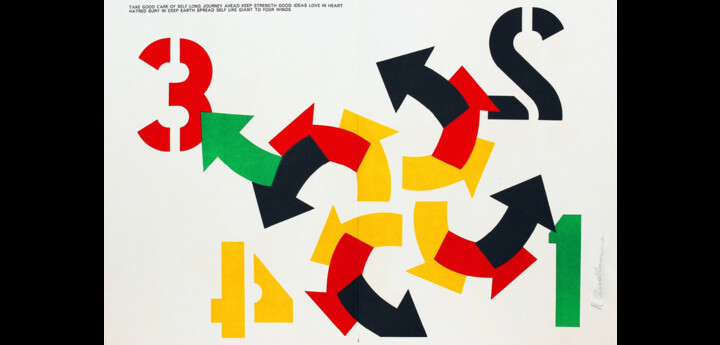Robert Indiana
Robert Indiana, born Robert Clark on September 13, 1928, in New Castle, Indiana, was a prominent American artist and a key figure in the Pop Art movement. Indiana is best known for his iconic LOVE series, which has become a universal symbol of affection and humanity.
Indiana's early life was marked by instability and hardship. He was adopted as an infant by Earl and Carmen Clark, and the family moved frequently during the Great Depression. This transient lifestyle, coupled with his experiences of small-town America, would later influence his artistic themes. Indiana served in the United States Army Air Forces before attending the Art Institute of Chicago, where he graduated with a Bachelor of Fine Arts degree in 1953. He then studied at the Skowhegan School of Painting and Sculpture in Maine and the Edinburgh College of Art in Scotland.
In 1954, Indiana moved to New York City, where he immersed himself in the burgeoning art scene. He adopted the surname "Indiana" to reflect his roots. By the early 1960s, Indiana had developed his distinctive style, characterized by bold, simple, and brightly colored text-based works. He drew inspiration from commercial art, signage, and American culture.
Indiana's breakthrough came in 1964 with the creation of his first LOVE painting, featuring the word "LOVE" in a square format with a tilted "O". This piece quickly resonated with the public and became a cultural phenomenon, reproduced in various forms, including sculptures, prints, and even a United States postage stamp in 1973. The design's success cemented Indiana's place in art history, though it also overshadowed much of his other work.
Despite being best known for LOVE, Indiana's oeuvre is diverse. His works often explore themes of American identity, personal history, and social justice. He created a series of paintings based on American road signs and symbols, such as "Eat/Die" and "Numbers". His "American Dream" series critiques consumerism and the American way of life.
Besides his work as a painter and sculptor, Indiana also engaged in creating posters and prints, and he ventured into theatrical set and costume design. Notably, he designed sets and costumes for the Santa Fe Opera's 1976 production of Virgil Thomson's The Mother of Us All, based on the life of suffragist Susan B. Anthony. Indiana also appeared in Andy Warhol's film "Eat" (1964), a 45-minute piece depicting him eating a mushroom, and Warhol's brief silent film "Bob Indiana Etc." (4 minutes, 1963), featuring appearances by Wynn Chamberlain and John Giorno.
In 1978, he moved to Vinalhaven, Maine, where he lived until his death. Despite his reclusive lifestyle, Indiana continued to produce art, including the HOPE series, which gained prominence during Barack Obama's 2008 presidential campaign.
Robert Indiana passed away on May 19, 2018, at the age of 89. His contributions to art have been celebrated in numerous exhibitions worldwide, and his works are held in major collections, including the Museum of Modern Art in New York, the Whitney Museum of American Art, and the Smithsonian American Art Museum. His bold and impactful imagery continues to influence contemporary artists and resonate with audiences around the globe.
Robert Indiana's iconic LOVE series
Robert Indiana's LOVE series is one of the most recognizable and celebrated bodies of work in contemporary art. The series originated in the 1960s and became iconic for its bold design and universal message.
The first LOVE painting was created in 1964, featuring the word "LOVE" arranged in a square format, with the "O" tilted to the right. The design is simple yet striking, utilizing bright, contrasting colors that draw immediate attention. This artwork encapsulates Indiana's distinctive style, which merges text and image to create a powerful visual statement.
Indiana's inspiration for the LOVE series came from various sources. The phrase "LOVE" was deeply personal to him, reflecting both his experiences and his broader philosophical and social concerns. He once explained that the inspiration partially stemmed from his upbringing in a Christian Science household, where the concept of love was central. Additionally, the design was influenced by the typography and signage prevalent in American culture, which he often incorporated into his works.
The LOVE series quickly gained immense popularity. In 1970, Indiana's LOVE sculpture was installed in the Indianapolis Museum of Art, which marked the beginning of numerous LOVE sculptures being commissioned and displayed worldwide. These sculptures often featured variations in color and size, but all maintained the original design's integrity. The LOVE sculpture became a symbol of peace and harmony during a turbulent era in American history, particularly resonating during the countercultural movements of the 1960s and 1970s.
One of the most notable moments in the LOVE series' history was the issuance of the LOVE postage stamp by the United States Postal Service in 1973. This stamp featured the red, green, and blue version of the LOVE design and was immensely popular, spreading Indiana's message of love and connectivity to a broad audience.
The impact of the LOVE series extends beyond its visual appeal. The artwork has been reproduced in countless forms, including prints, posters, jewelry, and merchandise. Its simple yet profound message has made it a universal symbol of affection, compassion, and human connection. Indiana's LOVE series has been displayed in major cities around the world, including New York, Philadelphia, London, and Tokyo, making it an integral part of public art.
Despite its commercial success and widespread recognition, the LOVE series also brought challenges for Indiana. He grappled with the work's commodification and the way it often overshadowed his other artistic endeavors. Nonetheless, the LOVE series remains a defining part of his legacy, encapsulating his ability to create art that speaks to the shared human experience.
Robert Indiana's LOVE series stands as a testament to the power of art to convey universal themes through simple, bold designs. It remains an enduring symbol of love and connection, resonating with audiences across generations and geographies.
Beyond "LOVE": The other notable works of Robert Indiana
Apart from his renowned "LOVE" series, Robert Indiana created several other notable works that have cemented his legacy in the art world. Here are some of his other famous pieces:
1. HOPE
Inspired by the "LOVE" series, Indiana created "HOPE" in 2008. The artwork features the word "HOPE" in a similar stacked format and vibrant colors, becoming a symbol of optimism. This piece gained widespread recognition during Barack Obama's 2008 presidential campaign and continues to represent a message of positivity and future possibilities.
2. EAT/DIE
Indiana's "EAT/DIE" series, created in the early 1960s, juxtaposes the words "EAT" and "DIE" in bold typography. The artwork explores themes of consumption and mortality, reflecting the artist's interest in the cyclical nature of life and death. These pieces are considered provocative and thought-provoking, embodying Indiana's ability to combine text with deeper philosophical meanings.
3. Numbers Series
In the "Numbers" series, Indiana created a set of artworks featuring the numbers zero through nine, each rendered in bright colors and distinctive fonts. This series highlights Indiana's fascination with numbers as symbols and their significance in everyday life. The "Numbers" series further showcases his signature style of using bold, simple forms to convey complex ideas.
4. The American Dream
"The American Dream" series, started in the 1960s, consists of paintings and prints that critique the idealized notion of the American Dream. Through the use of patriotic colors, stars, and stripes, Indiana explores themes of ambition, success, and disillusionment. This series underscores his critical view of American culture and its promises.
5. The Hartley Elegies
Inspired by the work of American modernist painter Marsden Hartley, Indiana created "The Hartley Elegies" in the late 1980s and early 1990s. This series of paintings pays homage to Hartley's depictions of German soldiers and explores themes of loss, remembrance, and the impact of war. Indiana's use of bold colors and symbolic imagery connects the personal with the historical.
6. Decade Autoportraits
In his "Decade Autoportraits," Indiana created a series of works that reflect significant events and experiences from each decade of his life. These autobiographical pieces blend text, numbers, and symbols, providing a visual narrative of the artist's personal journey and the cultural milestones that influenced him.
7. Peace Paintings
Indiana's "Peace Paintings," created in the 2000s, emphasize the theme of peace through the use of the word "PEACE" in various languages. These works are characterized by their vibrant colors and bold typography, similar to his "LOVE" series. The "Peace Paintings" reinforce Indiana's commitment to using art as a means of promoting harmony and understanding.
Robert Indiana's body of work extends beyond the "LOVE" series, demonstrating his versatility and depth as an artist. His ability to blend text with visual art has left an enduring impact on contemporary art, making his pieces both timeless and relevant.
Exhibitions and museum collections
Robert Indiana's artistic career is marked by several renowned exhibitions that have solidified his place in the annals of contemporary art. One of his early significant exhibitions, "Love Rising/Black and White Love" in 1968 at the Institute of Contemporary Art in Philadelphia, introduced his iconic "LOVE" sculpture to the public. This piece swiftly became a symbol synonymous with the counterculture and peace movements of the 1960s.
In 2013-2014, the Whitney Museum of American Art in New York City hosted a comprehensive retrospective titled "Robert Indiana: Beyond LOVE." This exhibition delved deep into Indiana's prolific career, not only showcasing his celebrated "LOVE" works but also exploring his engagement with American identity and political themes.
In 2023, the Farnsworth Art Museum in Rockland, Maine, commemorated Indiana's centennial with the exhibition "Indiana at 100: Robert Indiana and the Star of Hope." This retrospective offered a comprehensive look at his life and work, particularly his time spent in Vinalhaven, Maine, where he created many significant pieces.
The Albright-Knox Art Gallery in Buffalo, New York, organized "Robert Indiana: A Sculpture Retrospective" in 2018, focusing specifically on Indiana's contributions to sculpture. The exhibition featured a diverse array of his three-dimensional works, showcasing his versatility beyond his iconic two-dimensional pieces.
In 2019, the Asia Society Hong Kong Center presented "LOVE Long: Robert Indiana and Asia," exploring Indiana's influence in Asia and highlighting the universal appeal of his "LOVE" series across different cultures and continents.
Robert Indiana's artworks are prominently featured in museum collections globally. The Museum of Modern Art (MoMA) in New York, the Whitney Museum of American Art, and the Art Institute of Chicago hold significant collections of his works, including his "LOVE" sculptures and prints. Additionally, the Hirshhorn Museum and Sculpture Garden in Washington, D.C., and the Farnsworth Art Museum in Rockland, Maine, have dedicated spaces showcasing Indiana's enduring impact on modern art. His presence in these collections underscores his status as a pivotal figure in pop art and his lasting influence on contemporary artistic expression.
 Robert Indiana (After) - Love "Winter" Indian wool rug with classic Robert Indiana design 40x40x2cm
Robert Indiana (After) - Love "Winter" Indian wool rug with classic Robert Indiana design 40x40x2cm




 Selena Mattei
Selena Mattei







